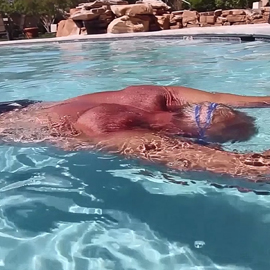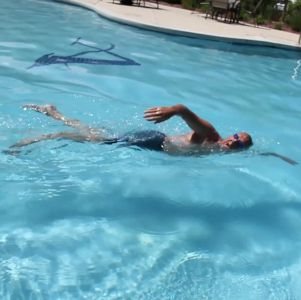Book Sample Chapter 47 Breaststroke Kicking
Read copy below or CLICK HERE to view PDF with pictures. CHAPTER 47 Breast
read moreHow to teach elementary backstroke swimming
No other stroke comes close to conserving your energy while getting more distance per stroke. In this stroke you will pull and kick at the same time then glide for as lo
read moreHow to teach the breaststroke swimming kick in 3 subroutines
You’ve maybe never looked at your foot in this way, but the inner border is thicker than the outer border. This is the similar shape of an airplane wing that gets lift
read moreLearn to swim from neutral position face float
The best way to learn this skill is to practice first stretched out on your mattress or floor. Place one hand on top of the other so that as you put your forehead down o
read moreMind control of body parts learning to swim efficiently
This is one of my six new teaching methods proven to get faster longer-lasting results. Learning to swim requires the mind to send a message to muscles to relax when you
read moreLearning freestyle swimming open turn
For all competitive and especially active lifestyle lap swimmers this is the ideal turn that makes you a swimmer. All you have to focus on doing is getting totally on yo
read moreLearning swimming freestyle flip turn
This skill is used mostly by competitive swimmers excluding triathletes. I would also suggest that older Senior Olympic swimmers consider doing open turns to get more va
read moreHow to teach yourself to float
Before you can float you have to master breath holding for at least 15-20 seconds and stay relaxed. A hot dog floats in water without lungs. Archimedes’ Physics Princi
read moreWhy lap swimming is good for your health and fitness
Water has more resistance than air and also removes the effects of gravity. Running and biking are great cardiovascular activities, but your joints also take a pounding
read moreWhy your head controls your body position
Newton’s Third Law of Motion states that for every action there is an equal and opposite reaction. If your adult head weighs 14-16 lbs. and is totally out of water to
read moreMy leg wraparound swim teaching method
This method is ideal teaching small children. It primarily uses the tool of “guidance.” It has one central purpose to immobilize as many body parts as possible. You
read moreWhen can I transfer swimming skills from home to pool?
Using a kitchen sink, dressing mirror, mattress, and a bath tub at home you can get familiar with all the basic swimming skills you’ll need to swim in a pool or lake.
read moreHow can I teach my child to swim early?
I tell parents the best age to start teaching your child to swim is 2-18 months. And you can start at home without a pool using a kitchen sink, dressing mirror, mattress
read moreWhy do you teach swimming at 2-18 months?
If you’re a parent you may have learned that up to 18 months your infant/child will copy and do whatever you ask or demonstrate. After 18 months their brain starts to
read moreHow can I teach breath holding?
This is an important skill every parent must demonstrate starting to teach their child to swim at 2-18 months! There are specific cues to use and visuals your child will
read moreHow can I learn to float?
I always say you float first and swim second. Let the water work for you and not against you. Recall how a hot dog is a piece of mea
read moreWhy 2-18 months is the best age to teach your child to swim
I started teaching my triplet boys in the bath tub pouring rinse water over their heads, breath holding, blowing big bubbles, kicking, and one arm stroking. Then I did th
read moreLearn to swim at home without a pool
Like any backyard sports skill you learn at home and practice to improve you then transfer those same familiar skills to the playing field or court. To build the basic s
read more

















